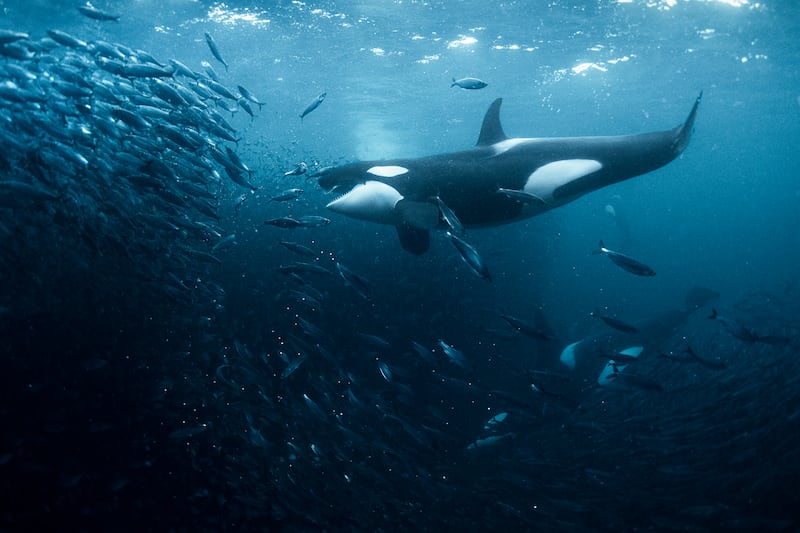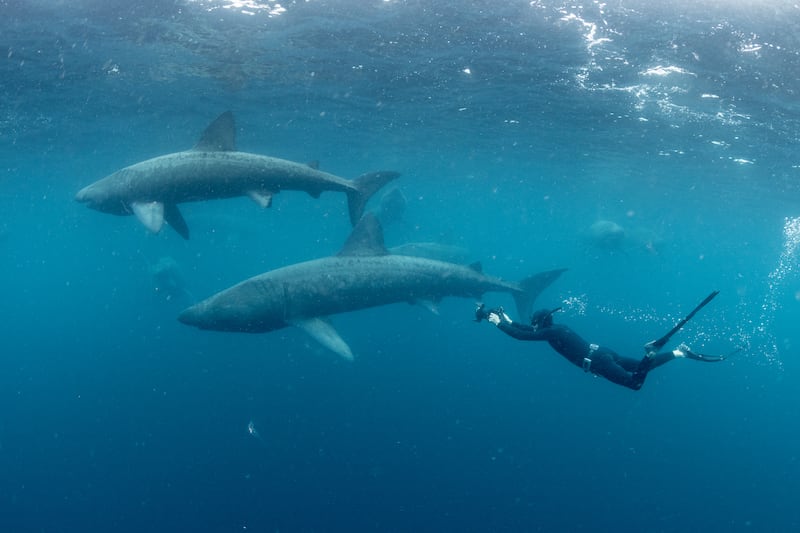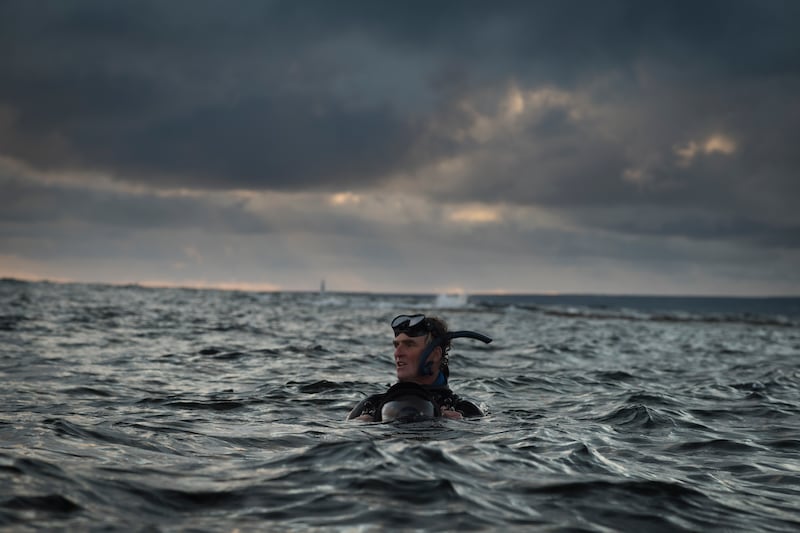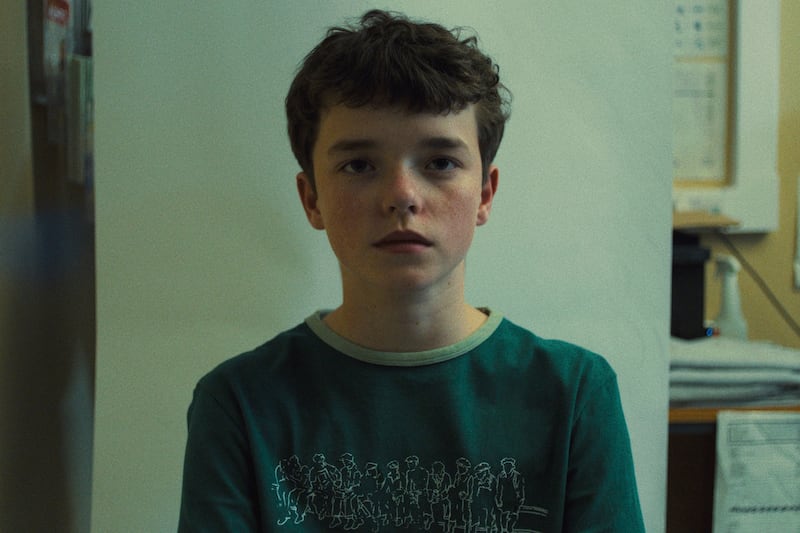“Even after all my years of diving in the North Atlantic, I still feel terrified swimming into the unknown,” says underwater cameraman Ken O’Sullivan, right before freediving into a vast, almost black ocean expanse: waves as far as the horizon, camera in hand.
The longest he can hold his breath for is 2 minutes and 45 seconds, but in the freezing waters off Ireland’s north coast, he might last just 40 seconds. Bubbles from scuba equipment can indicate aggression to whales nearby, so to get the shot he needs he must lower his heart rate, take a deep breath and press record.
“I used to dread the winter, the dark nights, poor weather, the cold,” he explains. “But I’ve made my peace with the elements — the energy of the ocean — that’s how I get to explore the underwater world.”



Opening with a St Brendan the Navigator quote in the comically overused Papyrus — a font that also somehow made it into Avatar — it’s easy to make initial assumptions about the production quality of North Atlantic (RTÉ One and RTÉ Player from 6.30pm on Sunday), but a montage of spectacular camerawork sets the mind at ease: This is no ordinary nature documentary. Little more is needed than O’Sullivan and his camera, although the drone shots come into their own.
Irish Tesla owners on Musk’s EV company: ‘I’m either stuck with it, or I have to take a big financial hit’
‘Our daughter is almost 40 and moving out soon, but she has told her son that he can stay with us’
‘I grew up in an apartment in another country. I bought an apartment in Dublin and had to get out after a year’
Adolescence: Five truths about our teenage boys we need to address urgently
His family hails from the same Co Kerry island as St Brendan (the Irish monk who famously trekked across the Atlantic in the 6th century), Fenit Island. For more than 18 years, O’Sullivan has been making nature documentaries; a previous documentary of his now sits on the Junior Cycle curriculum for Geography and Business Studies.
On the eve of Ireland’s first Covid-19 lockdown, his team received funding to shoot the three-part series, “to seek out enormous animals that once were plentiful, creatures that terrified our ancestors and to shine a light into the darkness of our perceptions”, he says.
In the first episode, O’Sullivan travels to the dark waters north of Ireland during winter, encountering a shoal of sprat tracked down by predators. The thrill of a tag team ambush between whales, dolphins and seabirds is nothing novel for the genre but remains a sight to reckon with. There are slow-motion waves aplenty.

Spectacular shots of Ireland’s rugged coast will no doubt please those in Tourism Ireland, but scenes of the Wild Atlantic Way are trumped as he travels north to Norway’s arctic fjords. Predators travel immense distances to be in the right place at the right time, waiting for a meal to sustain them for a long trek down to the Caribbean. On the search for a large shoal of herring, something rarely seen off Ireland today, O’Sullivan stumbles upon a feeding frenzy.
Amid the chaos of the chase, his impressive freediving camerawork depicts a curious choreography between animals: be it the gigantic scooping mounts of humpback whales, the brisk wrangling of orcas or the sweeping dive bombing from seabirds, each profit in some way from the underwater dance. And all this is set to a wonderful original score from 23-year-old Bradley Ayres, recorded by the RTÉ Concert Orchestra.
No self-respecting ocean documentary would be complete without the “we’re completely powerless to the sea” scene. Norwegian fjords are prone to sudden storms, O’Sullivan says, and as the local skippers were all hiding from the coronavirus, he was forced to battle “an enormous storm” without local aid. Repeatedly ramming into oncoming waves, the helplessness of the crew is evident.
“What should have been a one-hour journey [back to port], took almost four,” he says. “And I can’t help but think of St Brendan and his crew battling ocean storms under sail on their cowskin boat.”
Throughout the series, an undertone of wildlife conservation permeates the narrative. Taking such vast amounts from the bottom of the ocean’s food chain has had a knock-on effect in the North Atlantic, he says. “It’s absurd from an environmental point of view to take that much out of the ocean, and it’s more absurd from a financial point of view. Financially, ethically, and environmentally, it’s a terrible practice.
“There are a lot of issues, the greatest of which is overfishing on a global scale. That’s a complex issue, and I’m not for a second going to give Irish fisherman a kicking, but broadly across the planet we’re taking too much from the ocean and that’s impacting on the other life: the whales, the sharks, the dolphins, the seabirds that need that fish.”
The first episode ends on a dismal note, chronicling a recent washing up of the last living female orca from Ireland and Scotland’s “west coast community”, with 100 times the healthy level of toxins in its blubber, believed to be from human-generated pollutants that have leaked into the ocean.
“Although many of these pollutants have been banned since the 1980s, they still remain in the ocean, absorbed by fish and small creatures, eaten by larger fish and so on up the food chain to the top predators: sharks and whales,” he tells viewers.
Whales pass on these toxins through their milk to their young: “Over the last 25 years, the west coast community pod has never been seen with a calf.”
O’Sullivan is quick to mention, with the seriousness it deserves, that not a single killer whale has ever killed a human in the wild.













